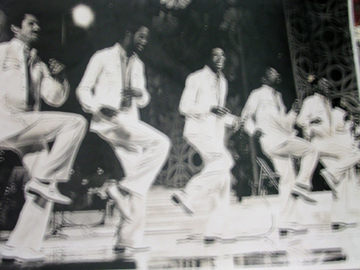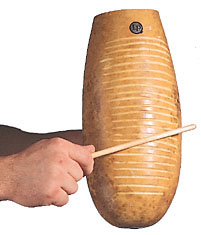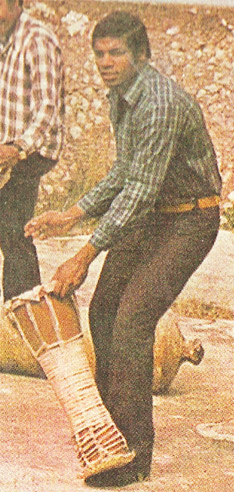Indice - Table of contents
Lo Nuevo[hide]
Musicos: Rafael Paseiro Monzón
Musicos: Dennis Nicles Cobas
Musicos: Jiovanni Cofiño Sánchez
Musicos: Yasser Morejón Pino
Fotos: Tom Ehrlich : 2024 Monterey Jazz, P...
Resenas: Vacilón Santiaguero (Circle 9 ...
Staff: Bill Tilford
Fotos: Tom Ehrlich : 2024 Monterey Jazz, P...
Fotos: Tom Ehrlich : 2024 Monterey Jazz Fe...
Fotos: Tom Ehrlich : testing 123
Grupos: Pupy y los que S... : Discography - 1995- F...
Reportes: From The St... : Cubadisco 2...
Reportes: From The St... : Jazz Plaza ...
Fotos: Tom Ehrlich : Irakere 50th Annivers...
Fotos Del Día [hide]
The Roots of Timba - Part II - Y se baila así

197? Ritmo Oriental- Y se baila así (Enrique Lazaga)
bass: Humberto Perera - congas: Juan Claro Bravo
güiro & arrangement: Enrique Lazaga
source: La historia de la Ritmo, Vol. 1
introduction:
ooxo xo0x ooxo xo0x congas
0xx0 xx0x x0xx 0xxx bass, strings, flute
The introduction features an unusual conga pattern with elements of the Puerto Rican bomba sicá rhythm that would later be very influential in timba. The bomba percussion pattern is clave neutral. In fact, everything in the introduction is clave neutral except for motivo part played by the bass, strings and flute. If the bass part were a timba kick drum pattern, it would be contraclave and indicate 2-3, but since there's no clave to be "contra" to, we'd have to say this introduction is in 3-2, although the rest of the song, like almost all the songs of this era, is in 2-3 rumba clave.
cuerpo A:
xx0x 0xxx 0xx0 xxx0 2-3 rumba clave
xx0x 0xxx 0xx0 xx0x
xx0x 0xx0 00x0 xxxx string guajeo
0xxx 0xxx 00x0 x00x bass
0xxx 0xx0 00x0 x00x tumbao 1 - MIDI
One of the main hooks of the arrangement is the punchy bass pickup that leads into the A-section of the cuerpo, which features a violin guajeo that's almost pure clave.
Humberto plays variations of this bass tumbao throughout the arrangement, with the only major departure being the B-section of the cuerpo, which begins as if it's going to be another walking bass line, but reverts to a slightly more legato version of tumbao 1 on the 3-side. Still, combined with the I - vi chord progression, it's enough to give the B-section a distinctly R&B flavor.
cuerpo B :
xx0x 0xxx 0xx0 xxx0 2-3 rumba clave
xx0x 0xxx 00x0 x00x string guajeo
0x0x 0xx0 x0x0 x00x tumbao -- MIDI
After the A and B sections repeat, we come to the first breakdown. Juan Crespo Maza's hilarious vocal rap on this section never fails to make me smile.
Like most of Ritmo Oriental's breakdowns this one removes the piano and strings, but retains the bass. In timba, we'll find the opposite to be true, with far-reaching implications in terms of dancing. As we've pointed out, Los Van Van and Irakere were already occasionally experimenting with this pivotal idea of removing the bass.
Coro 1 is very similar to the A-section of the cuerpo. The bass tumbao is different enough to call it tumbao 1b, but the string guajeo is completely different and very inspired.
coro 1:
xx0x 0xxx 0xx0 xxx0 2-3 rumba clave
0xx0 0xxx x0x0 xxxx
00x0 x0x0 x0x0 x0x0 string guajeo
0xxx xxx0 00xx xx0x
0xxx xxx0 00x0 x00x tumbao 1b -- MIDI
A short set of con efecto bloques leads to the second breakdown, which is also a gem.The bass part is almost the same and we'll cover it a little later as tumbao 1c, but the most interesting parts of the breakdown are the congas and güiro. Claro plays a marcha with no open tones (often called masacote), with slaps on the offbeats of the third beat:
breakdown 2:
xx0x 0xxx 0xx0 xxx0 2-3 rumba clave
xxSx xxSx xSxS xSSx conga slaps
Once again we find Claro hinting at rhythms which would become common practice in the timba era. The part Claro played on Sabroseao con la Ritmo was a precursor of bota. The key characteristic of bota is slaps or tones on the offbeats of beats 2 and 4 (xxxx x0x0 xxxx x0x0)
examples of bota conga marcha :
xxsx xsxs xxsx xsxs bota básica
xxsx xsxs xxsx x0xo bota variation 2
source: The Tomás Cruz Conga Method, Volume 2
Claro's part on the breakdown of Y se baila así, which moves the two accentuated offbeats to main beat 3, predates an even more common timba marcha, used by Charanga Habanera, Bamboleo, Issac and others as a change of pace during cuerpos and breakdowns where the singer talks to the crowd. It's sometimes called "charanga" and sometimes called "cha-onda". The term cha-onda comes from the style that Orquesta Aragón developed in the mid-70s when they briefly moved away from traditional charanga in response to Van Van's songo and la Ritmo's "nueva onda".
examples of cha-onda/charanga conga marchas:
xxSx xxoo x0x0 0xoo timba "charanga" marcha (source) - MIDI
00x0 xxoo 00x0 0xoo Aragón example (source)
 Lazaga's güiro part on the second breakdown is also wonderful. The part itself is a sped up variation on an early danzón rhythm called baqueteo, which according to Peñalosa holds the distinction of being the first clave-aligned rhythm to have been published in written music.
Lazaga's güiro part on the second breakdown is also wonderful. The part itself is a sped up variation on an early danzón rhythm called baqueteo, which according to Peñalosa holds the distinction of being the first clave-aligned rhythm to have been published in written music.
0x0x 0x0x 0x00 x00x traditional baqueteo
0x0x 0x0x 0000 x00x Lazaga's variation
The most exciting aspect of Lazaga's playing here - as it was on Mi socio Manolo - is the way he subtly, but powerfully, brings the tempo up from 119 to 124 bpm. Gollin and Holland recall seeing the band live and being astounded at Lazaga's ability to "conduct" the band with his güiro and body language.
The last coro of Y se baila así is a classic: Juana no me quiere porque yo no sé bailar ("my baby don't love me cuz I cain't dance"). By this time the tempo has peaked out at 127 and Humberto has trimmed a few notes from his tumbao accordingly. Meanwhile, the strings have switched from a melodic approach to a very rhythmic one which uses only two pitches
Before leaving Y se baila así, let's review tumbaos 1a, 1b and 1c, along with their corresponding string guajeos:
xx0x 0xxx 0xx0 xx0x
xx0x 0xx0 00x0 xxxx string guajeo
0xxx 0xxx 00x0 x00x
0xxx 0xx0 00x0 x00x tumbao 1 - MIDI
0xx0 0xxx x0x0 xxxx
00x0 x0x0 x0x0 x0x0 string guajeo
0xxx xxx0 00xx xx0x
0xxx xxx0 00x0 x00x tumbao 1b -- MIDI
0x0x xx0x x0x0 x00x string guajeo
0xxx xxxx 00x0 x00x
0xxx xxx0 00x0 x00x tumbao 1c -- MIDI
It's really the same bass tumbao, but Humberto makes subtle but clever changes to accomodate the markedly different string parts. It's tricky to avoid clashes and redundancies because bass and string parts in this type of music are based on the same rhythmic blueprint. To demonstrate, let's try the experiment of swapping the rhythms of the bass and strings in tumbao 1c:
audio track
MIDI
MIDI with parts swapped
To make the swapped file, I kept the notes basically the same but made the bass play the violin rhythm and made the violins plays the bass rhythm. It doesn't swing quite as much, but each part still sounds typical.
As explained in the "Sea of Holes" chapter, the dense texture of Cuban music is possible because certain instruments play in the spaces left open by others. Some instruments do this naturally, like bell and congas, or clave and kick drum. But making the bass, strings and piano lock together as well as they do in la Ritmo is an amazing achievement.
The last two songs from CA-718 aren't on La historia de la Ritmo, and we haven't even been able to find any record of EGREM ever releasing them on vinyl, although they obviously must have. Our recordings come from a bootleg bought in Little Havana by Cuban music expert Osvaldo Martínez, a source of endless help on this and other timba.com projects.
1974 Ritmo Oriental- Que se sepa bien, mi amor (J.C. Maza)
xx0x 0xxx 0xx0 xxx0 2-3 rumba clave
0xx0 x0x0 x0x0 x00x bass - MIDI
bass: Humberto Perera
source: write EGREM
notes: The North American influence, via Los Van Van, is prominent here in the chord progression and vocal style. Rhythmically, the bass follows the standard songo formula.
The heavily con efecto transition from the cuerpo to the montuno section is particularly nice harmonically:
BxxB BxBx xxxx BxBx bloque (B=Bloque)
BxxB BxBx xxxx BxBx
BxxB xxBBxBPPP PxBx (P=Piano)
CxxC xCxC xxxx xxxC a capella coro enters (C=Coro)
CxCC xCxC xCxC xCxx audio example
 Qué se sepa bien features an early example of Pedro Calvo actually singing. In his brief tenure with La Ritmo, prior to his epic 26 year stint with Los Van Van, Pedrito was used primarily for those campy, humorous interjections which are about the only as[ect of the early RO masterpieces that now sounds dated. Interestingly, after providing Los Van Van with its most prolific singer, La Ritmo did the same for NG La Banda fifteen years later, in the person of Tony Calá. As we'll see, La Ritmo got a lot more production out of Tony C before he moved on. Calá's 10 years as songwriter, lead vocalist and violinist with La Ritmo were arguably the best of his career. The third famous alumnus of Ritmo Oriental was violinist David Calzado, who of course went on to become the leader of La Charanga Habanera, utilizing many of the musical ideas he's learned in his apprenticeship with La Ritmo.
Qué se sepa bien features an early example of Pedro Calvo actually singing. In his brief tenure with La Ritmo, prior to his epic 26 year stint with Los Van Van, Pedrito was used primarily for those campy, humorous interjections which are about the only as[ect of the early RO masterpieces that now sounds dated. Interestingly, after providing Los Van Van with its most prolific singer, La Ritmo did the same for NG La Banda fifteen years later, in the person of Tony Calá. As we'll see, La Ritmo got a lot more production out of Tony C before he moved on. Calá's 10 years as songwriter, lead vocalist and violinist with La Ritmo were arguably the best of his career. The third famous alumnus of Ritmo Oriental was violinist David Calzado, who of course went on to become the leader of La Charanga Habanera, utilizing many of the musical ideas he's learned in his apprenticeship with La Ritmo.
The last song recording on the CA-718 session, Quién dice (La gorda), has been the cause of more than its share of discographical dementia. Like Que se sepa, mi amor, it only appears once in our list of EGREM sessions, with no LP shown. Osvaldo Martínez spoke to a member of Orquesta América who remembers being at EGREM in 1976 and witnessing Ritmo Oriental making a recording of La gorda, which went on to be a big radio hit. However, since our bootleg recording has the unmistakable voice of Pedro Calvo, I'm still contending that it's the earlier CA-718 version because by 1976 Pedrito had already left for Los Van Van.
197? Ritmo Oriental- Quién dice (La gorda) (J.C. Maza)
xx0x 0xxx 0xx0 xxx0 2-3 rumba clave
0xx0 xx0x x0xx 0xx0 bass - MIDI
bass: Humberto Perera
source: write EGREM
notes: The only unusual feature of Perera's driving bass tumbao is that it slams out the backbeat of the 3-side and omits the ponche. Maza's nicely-written cuerpo ends with a relatively easy-to-follow example of con efecto. Well, at least it's easy to follow once you realize that the time stops!
00x0 x0xx 00x0 x0xx con efecto bloque





















